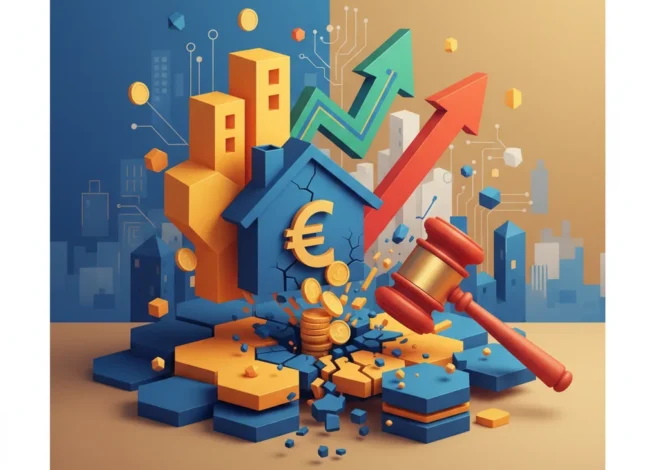
The Modern Investor’s Crossword: Decoding the Puzzles of Finance, Fintech, and the Future Economy
There is a unique satisfaction in solving a complex crossword puzzle. Each clue, whether cryptic or direct, is a self-contained challenge. Yet, the true magic happens when the answers begin to intersect, forming a coherent whole from disparate parts. Answering 7 Down might suddenly reveal the missing letter for 15 Across, creating a cascade of understanding that transforms a grid of empty squares into a completed masterpiece.
The world of modern finance operates much like an intricate, high-stakes crossword. To the uninitiated, it can appear as a daunting collection of disconnected jargon and volatile charts. However, for investors, business leaders, and finance professionals, understanding the interplay between its various components is not just a satisfying intellectual exercise—it is essential for navigating the complexities of the global economy. Today’s financial landscape is a grand puzzle where fintech innovation intersects with macroeconomic policy, where the principles of investing are challenged by new technologies like blockchain, and where the rules of banking and trading are being rewritten in real-time.
In this analysis, we will deconstruct this grand financial crossword. We will examine the key “clues”—the disruptive forces and foundational principles shaping our economic future—and explore how they connect to reveal the bigger picture. By understanding each piece, we can better position ourselves to not only solve the puzzle but to thrive in the ever-evolving world of finance.
The Across Clues: Fintech’s Unstoppable Disruption
The most visible and rapidly evolving clues in our financial puzzle are those related to financial technology, or fintech. These are the “Across Clues”—stretching horizontally across the entire industry, fundamentally changing how we save, borrow, invest, and transact. For decades, traditional banking was a monolithic industry, characterized by physical branches, rigid processes, and limited competition. Fintech has shattered that paradigm.
Consider the simple act of making a payment. What once required cash or a physical check can now be accomplished instantly with a tap of a smartphone. This shift is more than a convenience; it represents a fundamental rewiring of the financial system’s plumbing. Companies in the digital payments space have built global networks that challenge the long-held dominance of traditional card networks and banking institutions. This innovation has democratized access to financial services, with global fintech adoption rates climbing steadily. In fact, a recent industry report noted that the number of consumers using digital banking services has increased by over 60% since 2020.
The disruption extends far beyond payments. We see it in:
- Lending: Peer-to-peer (P2P) lending platforms and AI-driven credit scoring models are offering more accessible and competitive loans, bypassing traditional banks.
- Investing: Robo-advisors provide automated, algorithm-driven portfolio management at a fraction of the cost of a human advisor, opening up the stock market to a new generation of investors.
- Insurance: “Insurtech” leverages data analytics and IoT devices to offer personalized premiums and more efficient claims processing.
For business leaders and investors, the fintech revolution is a dual-sided puzzle. On one side, it presents an immense investment opportunity in disruptive startups. On the other, it poses an existential threat to incumbent institutions that fail to adapt. The key is to recognize that fintech is not just a technological upgrade; it’s a fundamental shift in business models, customer expectations, and the competitive landscape. Beyond the Bureaucracy: How Scrapping Red Tape Could Redefine the UK's Economic Future
The Down Clues: The Blockchain Enigma
If fintech represents the horizontal transformation of existing services, blockchain and its associated technologies are the “Down Clues”—vertical, foundational pillars that could underpin an entirely new financial architecture. For years, blockchain was almost exclusively associated with cryptocurrencies like Bitcoin. While that was its first major application, focusing solely on crypto is like looking at the invention of the internet and only seeing email. The true potential of distributed ledger technology (DLT) is far more profound.
At its core, blockchain is a system for creating a secure, transparent, and immutable record of transactions without a central intermediary. This seemingly simple concept has radical implications for finance, an industry built on trusted intermediaries like banks, clearinghouses, and exchanges. Institutional investment in blockchain infrastructure is projected to exceed $40 billion by 2025, according to a recent analysis, signaling a serious commitment to exploring its potential.
To understand its impact, let’s compare a traditional process with a blockchain-based alternative.
| Feature | Traditional Financial System | Blockchain-Based System (DeFi) |
|---|---|---|
| Trust | Relies on central institutions (banks, governments). | Relies on cryptographic proof and distributed consensus. |
| Transparency | Opaque; data is siloed within institutions. | Radically transparent; transactions are public on the ledger. |
| Settlement Time | Can take days (e.g., stock trades T+2). | Near-instantaneous or within minutes. |
| Accessibility | Often restricted by geography and requires a bank account. | Globally accessible with an internet connection. |
| Intermediaries | Multiple intermediaries, each adding cost and complexity. | Disintermediates or automates roles via smart contracts. |
The implications are vast. Blockchain could revolutionize everything from international trade finance and supply chain management to stock settlement and digital identity. However, it’s not a panacea. The technology still faces significant hurdles in scalability, regulation, and user experience. For investors, the challenge is to separate the transformative potential from the speculative hype.
The Cryptic Clues: Navigating a Volatile Stock Market
No financial crossword is complete without its “Cryptic Clues”—the complex, often counterintuitive dynamics of the public stock market. For many, the market is the primary interface with the world of investing and economics. Yet, its behavior has become increasingly puzzling in recent years.
We’ve witnessed the rise of meme stocks, where social media sentiment can drive valuations to irrational highs, completely detached from fundamental analysis. We’ve seen the proliferation of high-frequency trading, where algorithms execute millions of trades in milliseconds, creating a market environment that is opaque to the average human investor. The pandemic era further complicated the picture, with retail trading participation surging. The number of new brokerage accounts opened during the height of the pandemic saw a staggering increase, introducing a new and often unpredictable cohort of market participants.
In this environment, the old rules of investing—buy low, sell high; focus on P/E ratios and dividend yields—are still relevant, but they are no longer sufficient. Solving the modern market puzzle requires a multi-layered approach that acknowledges these new forces:
- Technological Influence: Understanding the impact of algorithmic trading and the role of AI in market-making is crucial.
- Behavioral Economics: Recognizing the power of market sentiment, herd behavior, and the psychological biases that drive investor decisions is more important than ever.
- Information Asymmetry: The speed at which information travels has accelerated, but the quality of that information has not always kept pace. Discerning signal from noise is a primary challenge.
For the long-term investor, the solution isn’t to try and “beat” the algorithms at their own game. Instead, it’s about reinforcing timeless principles—diversification, a long-term horizon, and a focus on fundamental value—while remaining aware of the new sources of volatility that can create both risks and opportunities. Beyond the Balance Sheet: The Post Office Scandal, a Murder Conviction, and the Hidden Risks in Modern Finance
The Big Picture: The Macroeconomic Framework
Finally, we arrive at the framework of the puzzle itself: the macroeconomic environment. All the individual clues—fintech, blockchain, market volatility—exist within this larger context. Interest rates, inflation, GDP growth, and geopolitical events are the borders of the crossword grid; they define the space in which all other pieces must fit.
A change in monetary policy by a central bank can dramatically alter the flow of capital into venture-backed fintech startups. A new regulatory framework can either accelerate or halt the development of blockchain applications. A spike in inflation can change investor behavior in the stock market, shifting preferences from growth stocks to value stocks.
Understanding these connections is the final and most critical step in solving the financial puzzle. An investor who is an expert on blockchain but ignores inflation, or a fintech entrepreneur who doesn’t understand the impact of rising interest rates on their business model, is only seeing a fraction of the board. The true masters of the game are those who can see the interplay between the micro and the macro.
Here is a simplified look at how key economic indicators can influence different asset classes:
| Economic Indicator | Potential Impact on Stocks | Potential Impact on Bonds | Potential Impact on Commodities |
|---|---|---|---|
| Rising Inflation | Mixed/Negative. Can erode profit margins but benefits companies with pricing power. | Negative. Reduces the real return of fixed-interest payments. | Positive. Often used as an inflation hedge. |
| Rising Interest Rates | Negative. Increases borrowing costs for companies and makes bonds more attractive. | Negative. Bond prices fall as yields rise. | Negative. Can strengthen the dollar, making commodities more expensive. |
| Strong GDP Growth | Positive. Indicates a healthy economy and growing corporate profits. | Negative. Can lead to inflation and higher interest rates. | Positive. Strong economic activity increases demand for raw materials. |
Hollywood's High-Stakes Gamble: Why a Warner Bros. Discovery Sale Could Reshape the Media Universe
Completing the Puzzle
Like a challenging crossword, the world of modern finance can be intimidating. It is filled with complex clues, interconnected systems, and a language all its own. However, by breaking it down into its constituent parts—the disruptive force of fintech, the foundational potential of blockchain, the cryptic behavior of the stock market, and the overarching macroeconomic framework—we can begin to see the bigger picture.
The solution is not a single, static answer. The financial crossword is a dynamic one, with new clues appearing every day. The key to success, for investors and business leaders alike, lies not in finding a final answer, but in embracing the continuous process of learning, adapting, and connecting the dots. It’s about developing the skill to see how a change in one corner of the grid can ripple across the entire puzzle, and having the strategic foresight to act accordingly.


